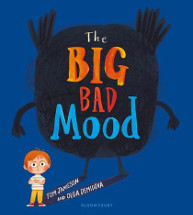The big bad mood by Tom Jamieson

Ill. by Olga Demidova. Bloomsbury, 2017. ISBN 9781408839201
(Ages: 3-6) Recommended. Feelings. Having spent most of his time
writing for television and radio, this is one of the author's first
forays into children's literature and is the illustrator's second
picture book (her first was Usborne's Peep inside the Farm).
Their relative newness to the field is not apparent as this
collaborative effort pairs witty and age-appropriate writing with
attention-grabbing illustrations that successfully capture the
emotions of the main characters. An appealing and well-designed
front cover with bold colours draws the eye immediately and children
will want to find out more about this big, dark creature (the
personified Big Bad Mood who looks a bit like a blue Mr Chicken).
The story features George, who is having a particularly bad day.
When his mum tells him that there is a big bad mood hanging around
him he goes looking and finds 'a curious fellow, rough like
sandpaper and smelling of socks which REALLY needed changing'.
Children will identify with George; everyone has had one of those
days and done their fair share of stomping, shouting and huffing and
puffing. They will also love hearing about the mischief George is
dragged into by his Big Bad Mood: making a Big Bad Mood Sandwich
with caterpillar legs and spider mayonnaise, and filling the
swimming pool with jelly and custard. The Big Bad Mood is having a
great time but George is getting a bit tired of being grumpy (it is
hard work and his friends aren't very happy) so off he goes to tidy
up, to say sorry to those he might have hurt, and play happily with
his friends. Making the Big Bad Mood an incredibly happy,
enthusiastic character (rather like Drop Dead Fred), whose job is to
make everyone grumpy, is great as it adds a life and humour that may
have been missed if it had been a grump itself. This is a great
reminder to children that it is ok to have grumpy days when they
don't want to share or play nicely with their friends but that their
friends won't want to play with them if they are in a bad mood all
the time. It also shows young children how to deal with the
aftermath of a grumpy episode (saying sorry, tidying up) and gives
them the language to talk about their emotions and frustration with
their parents, teachers, and friends.
Nicole Nelson